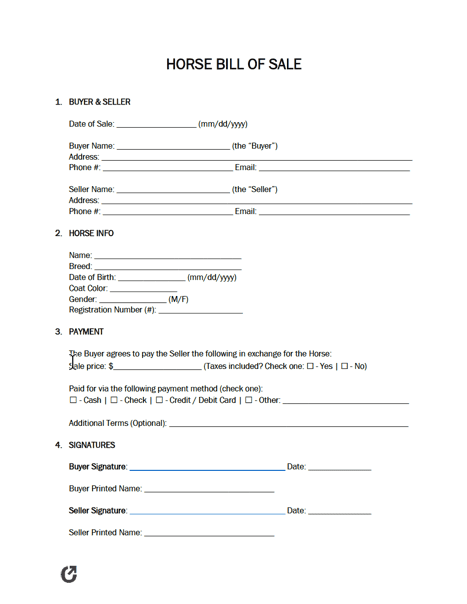Horse Bill of Sale Form
A horse bill of sale is a form that is used when a buyer purchases a pony or horse from a seller. The main purpose of the document is to prove that the buyer paid in full before acquiring it. After it has been signed, the seller is no longer responsible for the injury or death of the horse. However, the merchant must tell the buyer if the animal is predisposed to illness or has a disease before the transaction occurs. The information provided by the seller must be included in the form as proof that the buyer was notified.

How to Sell a Horse (4 Steps)
Step 1 – Prepare
Before selling, it is important to prepare the horse so that it looks its best. Begin by cleaning it thoroughly. Specifically focus on the hooves, face, tail, and eyes since those areas tend to be the dirtiest. If the animal is cleaned regularly, this step should not be an issue. Nonetheless, it can be helpful to brush the horse or clear away dirt before buyers come to view it.
The horse’s living space should be clean. A tidy barn or paddock will show that the seller takes good care of the animal. This means that the area is free of manure and garbage or decaying items. Plants, grass, and trees should be trimmed, as well. Repairing rotting fences and fixing anything that is out of place will also boost its appearance.
When the buyer meets the horse, they will likely ask the seller if it is up-to-date with vaccinations, medications, and general check-ups. To prepare for this situation, make a copy of the pony’s medical records so that they can be accessed during the showing.
Step 2 – Set Price
Age plays a large role in the price of a horse. On average, these animals often live to twenty-five (25) or thirty (30) years of age. However, older equines may be more likely to suffer from disease or illness. That said, a buyer will pay much less for an older horse in comparison to a younger one.
Other factors, like bloodline, health status, predispositions to illness, and much more, can impact the cost, as well. Since there are many variables to consider when selling a horse, it is recommended that the seller has it appraised. Many online tools can provide estimates. Similarly, local farms or breeders may be able to suggest an asking price.
Step 3 – Advertise
Online services are available that are used to list and sell a horse. They can help the animal to be recognized by many people around the world. Unique breeds can be especially valuable and catch the eye of buyers.
Before listing the horse, however, it is essential that the site is trustworthy. Many sellers can be scammed after entering personal information into websites that are not legit.
Local veterinarians can be a great resource for selling a horse, as well. They may allow listings in their office or let clients know about the sale. Similarly, it can be helpful to share the news with farmers, friends, family, or anyone who can spread the word.
Once the horse is listed for sale, potential buyers may come to view the horse. The seller should appear confident and professional so that the buyer trusts them.
Many sellers choose to perform background checks on interested buyers. Having a clear understanding of who the buyer is will ensure that the horse goes to a caring owner.
Step 4 – Sign
A bill of sale includes important information about a transaction. Having the details in writing about how the transfer occurred will protect both parties. It will also make it easier if there are ever any questions about the sale. When completing the document, it is critical to add the following:
- Description – This section needs to be thorough. It should include the horse’s name breed, date of birth, coat color, gender, and/or registration number.
- Contact Infomation – The name of the buyer and seller, address, phone number, and email should all be listed in the document.
- Payment Details – The form should clearly explain when the buyer paid and the payment method that they used (i.e. cash, credit card, check, etc.)
